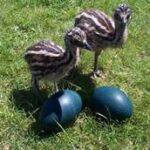“If you want to make an omelet, you have to break a few eggs’” or so goes the old saying. But, to raise emus, you have to hatch a few eggs. Now, what does a farmer do with all the eggs that they don’t intend to hatch? It’s amazing what can be done with these dark green eggs and their shells!
Emu eggs are edible and quite nutritious. With a volume equal to 10 chicken eggs, a single emu egg can make breakfast for a crowd. The emu egg has a greater quantity of yolk compared with white than the chicken egg, as well as less water overall. The amount of fat (percentage-wise) in an emu egg is, also, greater; 16% lipids (fats) in the emu egg compared to 10% lipids in the chicken egg. However, if you look at the “good” fats versus the “bad” fats, the emu egg has a lower percentage of bad fats. These nutritious eggs contain 68% unsaturated fat and 8 of the 10 essential amino acids we require, including Lysine. Lysine plays a major role in building muscles, calcium absorption, and the production of hormones, enzymes, and antibodies. These eggs are great for baking, producing moist, fluffy cakes and delectable cookies. Did you know it can take more than an hour of simmering to hard boil an emu egg?
Besides eating emu eggs, small amounts of emu egg can be used as an ingredient in making soaps to add fat soluble vitamins A, D, E and K. Egg yolks provide lecithin, a natural antioxidant and emollient while, the egg whites add rich protein and helps to tighten skin.
Once the egg’s contents have been used, it’s time to focus on the beautiful green eggshell. These large, dark green eggs with layers of dark green, turquoise and white, lend themselves to the creation of beautiful art work. The eggs are first washed and sanitized. Then the eggs can be painted and hung like Christmas ornaments, made into jewelry boxes and music boxes, or decorated like the famous Faberge eggs.
Many artists carve emu eggs because of the different color layers. The dark green outer covering varies from hunter green to almost black. The middle color is a teal green; the inside a bright white. The teal is actually as many as seven subtle layers of color, each about the thickness of a sheet of paper. These different layers of color can be utilized to add texture and depth to artwork and make even a simple design dramatic. The texture, contrast and natural colors of the shell make even a simple design dramatic. Many interesting items, including nightlights, can be made from a lacework cut eggshell.
Pieces of emu egg shell can be used to make inserts for jewelry and the smaller broken pieces can be used to make mosaic artwork.
An emu can stand nearly 6 feet tall and weigh over 110 pounds. The emu lays a dark green egg that has an average weight of almost two pounds. Most emu hens will lay an egg every three days during their laying season which, here in the northern hemisphere is October through April.
While emu egg shells can be found throughout the year, edible emu eggs are seasonal items that are only available during the laying season, at select groceries and through your local emu farmer. For more information about emu or emu eggs, contact the American Emu Association (AEA) at http://www.aea-emu.org or call 541-332-0675.
#####

